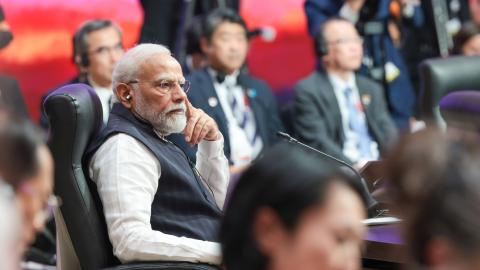Indian Prime Minister Narendra Modi, as host of the G-20 summit in Delhi and coming on the heels of the BRICS summit, is eager to fulfill his proclaimed desire of making India the “Voice of the Global South.” As the world’s most populous country and one of the fastest growing economies, India seeks to reflect the interests of the vast majority that does not live in the industrialized northern half of the globe.
BRICS originated as a grouping of five emerging economies — Brazil, Russia, India, China, and South Africa — but has now admitted Saudi Arabia, Iran, Ethiopia, Egypt, Argentina and the United Arab Emirates, making it a larger group of influential developing nations. In some ways, it is the latest incarnation of India’s leadership role in the Non-Aligned Movement (NAM), which at its height during the Cold War comprised 120 countries.
Most countries prefer a multipolar world over one in which they must tie their fortunes to one or two superpowers and get bound by the superpowers’ preferences. But the Non-Aligned effort taught the movement’s leaders an important lesson: It is easier to gather those not wishing to be camp followers of a global hegemon; it is more difficult to create a new, truly multipolar world order. In the end, realpolitik and hard power often trump the influence mustered through summit meetings and resolutions.
For that reason, the BRICS expansion seems to be based on bringing together middle powers that are influential within their regions and wield economic clout. The new grouping is also more specifically focused on trade and expanding economic opportunities, instead of becoming a “talk shop” decrying Western influence. That is a critical distinguishing characteristic of the expanded BRICS and the erstwhile NAM.
The United Arab Emirates took the lead in declaring that its joining the BRICS bloc will not be at the expense of its ties with Western nations. By timing the G-20 summit almost back-to-back with the BRICS meeting, Modi wants to convey the same message.
India’s External Affairs Minister, Dr. Subrahmanyam Jaishankar,has said that India seeks “to engage America, manage China, cultivate Europe, reassure Russia, bring Japan into play, draw neighbours in, extend the neighbourhood, and expand traditional constituencies of support.” That is why India has sought to host, within the span of a year, the summit meetings of the G-20, BRICS, and the Chinese-led Shanghai Cooperation Organization (SCO).
Russia and China are not likely to easily let India and others remain close to the West while developing the notion of the “Global South,” which is why both Moscow and Beijing have thrown a wrench into Modi’s otherwise perfect plan for positioning India as host to all major and middle powers at the same time. While President Joe Biden will attend the G-20 summit and will also meet Modi separately, Russian President Vladimir Putin and China’s strongman, Xi Jinping, will not be there. Their governments have even threatened to block any final G-20 declaration unless it reflects their positions on various crises, including Ukraine.
Still, India seems poised to cement its place at the global high table. It held the presidency of the UN Security Council in December 2022 and convened the Global South Summit in January.
India participated in the G-7 and Quad summits in Japan in May; hosted the SCO summit in July; welcomed new members at the August BRICS summit; and is hosting the G-20 summit in September, the first ever to be held in South Asia.
A recent survey shows that many around the world view India favorably. According to the Pew Research Center, 46 percent of adults across 23 countries hold a favorable view of India. While there has been a drop in favorability of India in European countries, favorable views of India are high in the U.S. and its traditional allies like the United Kingdom, Israel, South Korea, Japan and Australia.
For the U.S. and its allies, India’s diplomatic leverage and soft power make it a potential bridge with the former non-aligned developing world — a world that no longer views America as the sole superpower.
Although formal military alliances have been the backbone of U.S. grand strategy so far, Americans increasingly see the value of viewing their friends as part of “minilaterals” and regional groupings. It is a prudent nod to diplomatic realism in an era when most countries want to avoid having to choose sides in contests for global primacy.
For its part, India is using the G-20 forum to bolster ties with partners in the Middle East, Africa and Asia. In addition to the world’s largest economies and the European Union, which constitute the G-20’s membership, seven guest countries from what India will also attend the G-20 summit this year: Bangladesh, Egypt, Mauritius, Nigeria, Oman, Singapore, and the United Arab Emirates.
Modi faces a parliamentary election next year, which most observers expect him to win. Standing next to President Biden and several other world leaders over the coming weekend, Modi will effectively be campaigning while also positioning India as a major global player.


















